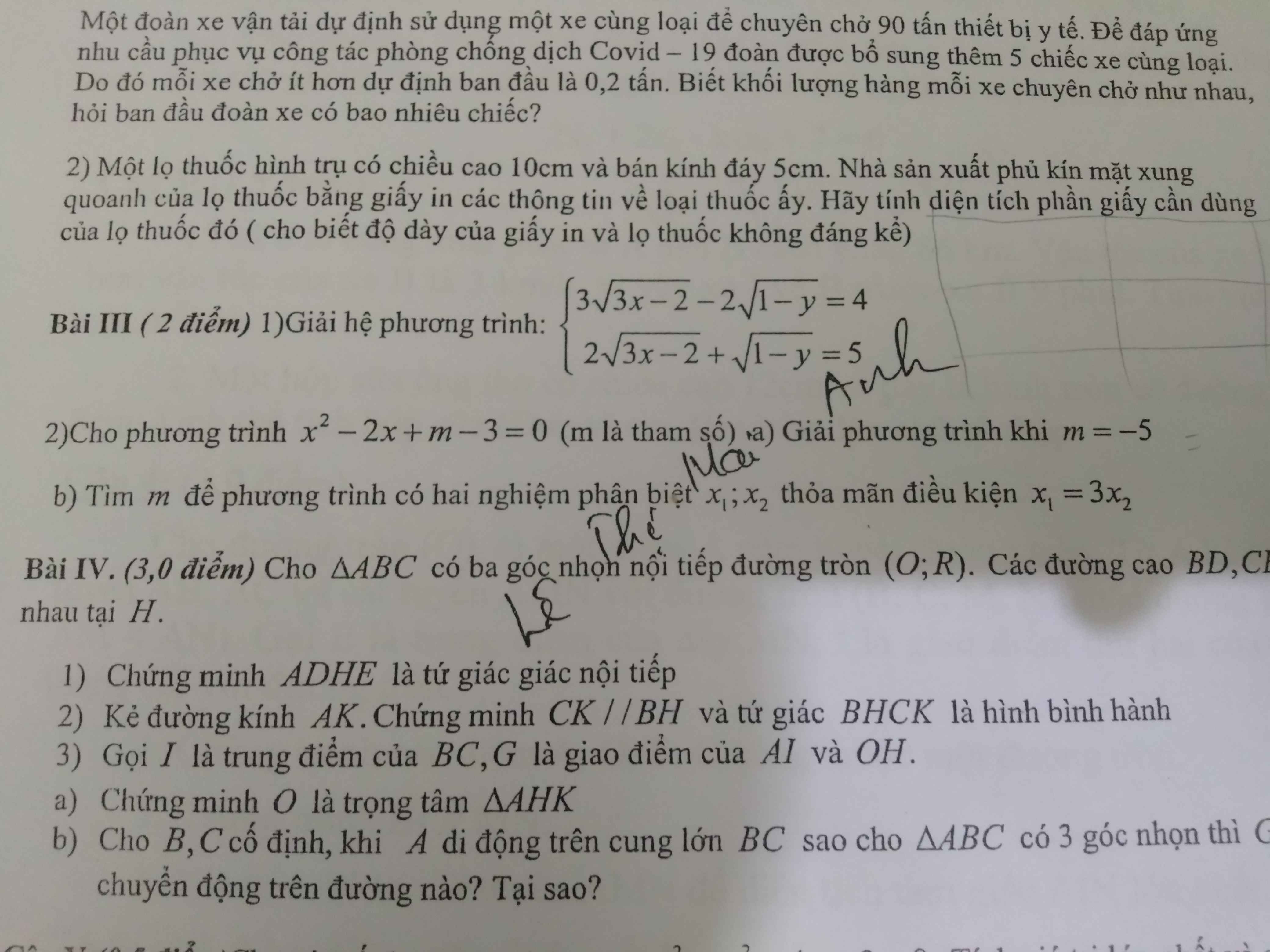Hãy nhập câu hỏi của bạn vào đây, nếu là tài khoản VIP, bạn sẽ được ưu tiên trả lời.

a: Khi m=2 thì pt sẽ là \(x^2-8x-9=0\)
=>x=9 hoặc x=-1
b: \(\text{Δ}=\left(2m+4\right)^2-4\left(-2m-5\right)\)
\(=4m^2+16m+16+8m+20=4m^2+24m+36\)
\(=4\left(m^2+6m+9\right)=4\left(m+3\right)^2>=0\)
Để phương trình có hai nghiệm phân biệt thì m+3<>0
hay m<>-3
Theo đề, ta có: \(\sqrt{\left(x_1+x_2\right)^2-4x_1x_2}=2\)
\(\Leftrightarrow\sqrt{\left(2m+4\right)^2-4\left(-2m-5\right)}=2\)
\(\Leftrightarrow\sqrt{4m^2+16m+16+8m+20}=2\)
\(\Leftrightarrow4m^2+24m+36=4\)
\(\Leftrightarrow m^2+6m+9=1\)
=>m+3=1 hoặc m+3=-1
=>m=-2 hoặc m=-4

\(x^2+\left(4m+1\right)x+2\left(m-4\right)=0\)
\(\Delta=\left(4m+1\right)^2-4\cdot1\cdot2\left(m-4\right)=16m^2+8m+1-8m+32=16m^2+33\ge33>0\forall m\)
\(\Leftrightarrow\left\{{}\begin{matrix}x_1=\dfrac{-\left(4m+1\right)+\sqrt{16m^2+33}}{2}\\x_2=\dfrac{-\left(4m+1\right)-\sqrt{16m^2+33}}{2}\end{matrix}\right.\)
Mà: \(x_2-x_1=17\)
\(\Leftrightarrow\dfrac{-\left(4m+1\right)-\sqrt{16m^2+33}}{2}-\dfrac{-\left(4m+1\right)+\sqrt{16m^2+33}}{2}=17\)
\(\Leftrightarrow\dfrac{-\left(4m+1\right)-\sqrt{16m^2+33}+\left(4m+1\right)-\sqrt{16m^2+33}}{2}=17\)
\(\Leftrightarrow\dfrac{-2\sqrt{16m^2+33}}{2}=17\)
\(\Leftrightarrow\sqrt{16m^2+33}=-17< 0\)
Vậy không có m thỏa mãn

1: Để phương trình có hai nghiệm trái dấu thì m<0
2: Để phương trình có hai nghiệm thì Δ>=0
=>36-4m>=0
=>m<=9
Theo đề, ta có:
\(\left\{{}\begin{matrix}x_1-x_2=4\\x_1+x_2=6\end{matrix}\right.\Leftrightarrow\left\{{}\begin{matrix}x_1=5\\x_2=1\end{matrix}\right.\)
Theo đề, ta có: \(x_1x_2=m\)
=>m=5(nhận)

a) \(x^2-mx+2m-4=0\) nhận \(x=3\) là nghiệm nên:
\(3^2-m.3+2m-4=0\)
\(\Leftrightarrow9-3m+2m-4=0\)
\(\Leftrightarrow m-5=0\)
\(\Leftrightarrow m=5\)
Vậy phương trình trở thành: \(x^2-5x+6=0\) nhận x=3 là nghiệm vậy nghiệm còn lại là:
\(\Delta=\left(-5\right)^2-4.1.6=1\)
\(\Rightarrow\left\{{}\begin{matrix}x_1=\dfrac{-b+\sqrt{\Delta}}{2a}=\dfrac{-\left(-5\right)+\sqrt{1}}{2.1}=3\\x_2=\dfrac{-b-\sqrt{\Delta}}{2a}=\dfrac{-\left(-5\right)-\sqrt{1}}{2.1}=2\end{matrix}\right.\)
Vậy nghiệm còn lại là \(x=2\)

\(-x^2+\left(m+2\right)x+2m=0\)
\(\Delta=\left(m+2\right)^2+8m=\left(m+6\right)^2-32\)
Để phương trình có 2 nghiệm phân biệt
<=> \(\Delta>0\Leftrightarrow\left(m+2\right)^2>32\Leftrightarrow m>\sqrt{32}-2\)
Vì phương trình có 2 nghiệm phân biệt
Áp dụng hệ thức vi ét
\(\Rightarrow x_1+x_2=m+2\)
=> \(\left\{{}\begin{matrix}x_1+x_2=m+2\\x_1+4x_2=0\end{matrix}\right.\)
\(\Rightarrow m=-3x_2-2\)
Bạn xem lại đề chứ k tìm được m luôn á

\(x^2-2\left(2m+1\right)x+4m^2+4m=0\)
Để pt có hai ng pb\(\Leftrightarrow\Delta>0\)
\(\Leftrightarrow4>0\left(lđ\right)\)
\(\Rightarrow\)Pt luôn có hai ng pb với mọi m
\(\left\{{}\begin{matrix}x_1=\dfrac{2\left(2m+1\right)+\sqrt{4}}{2}=2m+2\\x_2=\dfrac{2\left(2m+1\right)-\sqrt{4}}{2}=2m\end{matrix}\right.\)
Có \(\left|x_1-x_2\right|=x_1+x_2\)
\(\Leftrightarrow\left|2m+2-2m\right|=2m+2+2m\)
\(\Leftrightarrow2=4m+2\)
\(\Leftrightarrow m=0\)
Vậy...

Đẻ pt 1 có 2 nghiệm pb => \(\Delta,>0\) <=> 1-m+3>0 <=> m<4
Với m<2 thì pt 1 có 2 nghiệm pb x1 x2
=> Theo hệ thức vi ét ta có :
\(\left\{{}\begin{matrix}x1+x2=2< \cdot>\\x1.x2=m-3< \cdot\cdot>\end{matrix}\right.\)
Theo bài ra ta có : x1= 3x2 <=> x1 - 3x2=0 <*>
Từ <*> và <.> ta có hpt
\(\left\{{}\begin{matrix}x1+x2=2\\x1-3x_2=0\end{matrix}\right.\)
Giả ra ta dc: <=>\(\left\{{}\begin{matrix}x1=\dfrac{3}{2}\\x2=\dfrac{1}{2}\end{matrix}\right.\)
Thay x1 và x2 vào <..> ta dc
\(\dfrac{3}{2}.\dfrac{1}{2}=m-3\)
<=> m = \(\dfrac{15}{4}\left(tm\right)\)
Vậy m = ... là giá trị can tìm

a) Ta có: \(\Delta=\left(-4\right)^2-4\cdot1\cdot\left(2m-3\right)=16-4\left(2m-3\right)\)
\(\Leftrightarrow\Delta=16-8m+12=-8m+28\)
Để phương trình có hai nghiệm x1;x2 phân biệt thì \(-8m+28>0\)
\(\Leftrightarrow-8m>-28\)
hay \(m< \dfrac{7}{2}\)
Với \(m< \dfrac{7}{2}\) thì phương trình có hai nghiệm phân biệt x1;x2
nên Áp dụng hệ thức Viet, ta có:
\(\left\{{}\begin{matrix}x_1+x_2=\dfrac{-\left(-4\right)}{1}=4\\x_1\cdot x_2=\dfrac{2m-3}{1}=2m-3\end{matrix}\right.\)
Để phương trình có hai nghiệm x1,x2 phân biệt thỏa mãn tổng 2 nghiệm và tích hai nghiệm là hai số đối nhau thì
\(\left\{{}\begin{matrix}m< \dfrac{7}{2}\\4+2m-3=0\end{matrix}\right.\Leftrightarrow\left\{{}\begin{matrix}m< \dfrac{7}{2}\\2m+1=0\end{matrix}\right.\)
\(\Leftrightarrow\left\{{}\begin{matrix}m< \dfrac{7}{2}\\2m=-1\end{matrix}\right.\Leftrightarrow\left\{{}\begin{matrix}m< \dfrac{7}{2}\\m=-\dfrac{1}{2}\end{matrix}\right.\Leftrightarrow m=-\dfrac{1}{2}\)
Vậy: Khi \(m=-\dfrac{1}{2}\) thì phương trình có hai nghiệm x1,x2 phân biệt thỏa mãn tổng 2 nghiệm và tích hai nghiệm là hai số đối nhau